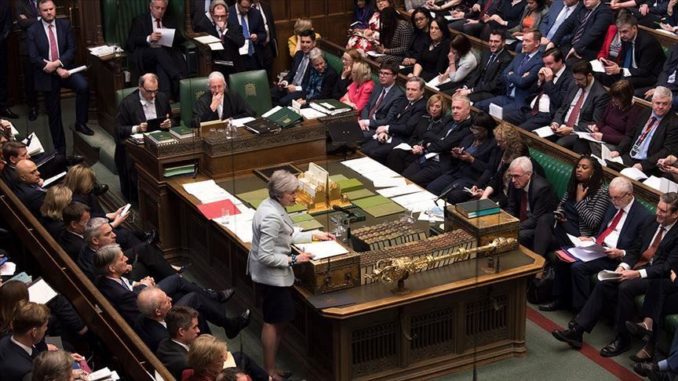
British parliament is voting Wednesday evening on a series of alternatives to Prime Minister Theresa May’s Brexit deal, which has been rejected by lawmakers twice previously.
The voting will take place at 7 p.m. local time to see which options have a parliamentary majority behind them in a bid to break the Brexit impasse in Westminster.
As the results will not be binding for the government, May is expected to bring her deal back to the House of Commons for a third “meaningful vote”.
She told lawmakers during a question session earlier on Wednesday that meaningful vote would be “this week”.
A government spokesperson later said “we will only seek to bring back a meaningful vote when we believe we have a realistic prospect of success.”
May also made it clear that she will not necessarily accept any Brexit plan that will possibly emerge from Wednesday’s indicative votes process.
What is being voted?
John Bercow, the parliament speaker, announced the list of motions to be voted a few hours before the vote takes place, following the MPs moved the motion on the parliament business to go ahead for the indicative votes with a majority of 44 votes.
The options to be voted are as follows:
1. Leaving the EU without a deal on April 12,
2. Leaving the EU with a Norway model + (remaining in single market, customs union arrangements and European free trade area),
3. Leaving the EU with a Norway model without a customs union,
4. Leaving the EU with a U.K.-wide customs union,
5. Leaving the EU with a permanent customs union including alignment with the single market on future EU rights and regulations,
6. Revoking the Article 50 — the section of the EU treaty under which the U.K. is leaving — if no-deal Brexit was not explicitly approved by MPs a day before the exit date,
7. Putting any withdrawal agreement to public “confirmatory” second referendum, and
8. Seeking a “standstill” agreement with the EU while negotiating a trade deal if no withdrawal agreement was agreed.
Votes non-binding
Professor Alex de Ruyter, an expert on Brexit from Birmingham City University thinks “there is still the distinct prospect of no deal.”
“If Parliament does not pass Mrs May’s withdrawal agreement then the U.K. has until April 12 to come up with a credible alternative approach to Brexit or leave without an agreement,” he told Anadolu Agency.
“The parliament of course had to approve extending Article 50 period beyond March 29 for this to be legally binding under the U.K. law,” he said.
Today’s indicative votes “are not legally binding on the government to obey, as Theresa May has noted,” de Ruyter said.
He added: “It is possible that the parliament could vote on an agreed plan (e.g. Norway option) and try and push this via statute but this would be very difficult to execute, and raise tricky constitutional issues as it is the government, not the parliament in the U.K. that is meant to propose legislature.
“In any event it would still need the executive (i.e. the PM) to then go to Brussels and negotiate (i.e. plead) with EU leaders for a longer extension, which Theresa May clearly does not want to do.
“Any of these are possible, maybe even revoking Article 50 (which is the one thing the government wouldn’t need EU’s permission to do before the exit date).”
Hard to reach majority
“What is most probable?,” de Ruyter questioned.
He said: “I think the parliament will struggle to come up with a clear majority alternative to May’s agreement.
“If they do however, then I think May will return her bill to the parliament say on Thursday this week, and try to cajole Brexiters and the DUP (Democratic Unionist Party) into voting for it on the premise that they risk a softer Brexit, or no Brexit, if they don’t.
“Will that be enough to get May’s agreement over the line? I still don’t think so. We will then have to see if the PM really is prepared to risk no deal by continuing this stand-off against the parliament.”
BY ANADOLU AGENCY
